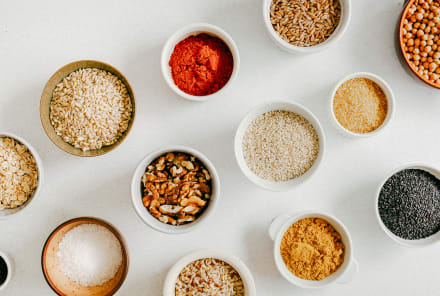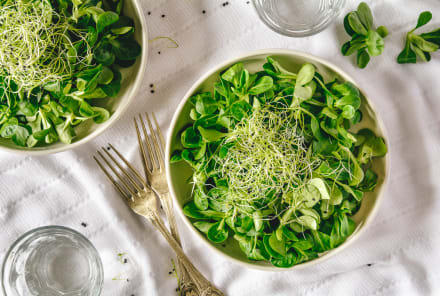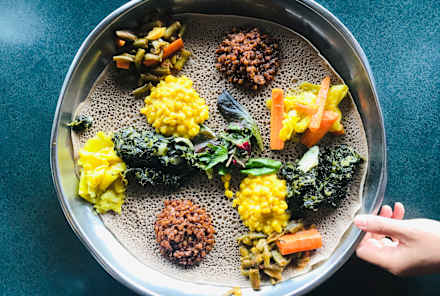Advertisement
What Is A Cashew Apple & Does It Have Any Health Benefits?

Though you might be familiar with the much-loved cashew nut, there's another part of the tree that deserves some notice—its fruit. With a colorful, pear-like exterior and a fleshy interior, cashew fruits are commonly known as "apples," which derive from the evergreen cashew tree or Anacardium occidentale. There's so much to learn about this Brazilian-native fruit, its culinary applications, and its potential health benefits.
What is a cashew apple?
Cajú, alcayoiba, anacardo, cajuil, Indian nut, marañón, pepa, or merey are some of the most common global names associated with cashews. Although technically a seed, cashew nuts are the most popular part of the tree—beloved for their creamy texture, high-fat content, and nutrient-rich profile.
Despite the nuts' dietary praise, their apples (or pseudo fruits) remain mostly out of the spotlight. The cashew apple—or the plump part of the cashew fruit, connected to the cashew nut—looks like a mini, oval-shaped boxing glove. Botanically speaking, cashew apples are so-called accessory fruits because they grow after cashew seeds have fully developed. Thus, the actual drupe or peduncle is the kidney-shaped shell enclosing the edible cashew nut, which you'll find at the end of the apple.
Cashew trees are native to Brazil's and Venezuela's tropical zones and have been growing wild since ancient times. Their introduction to coastal India and Mozambique began in the 16th century, thanks to Portuguese seed traders, and eventually expanded farther into Asia and Africa. Today, cashew trees are found globally across most warmer regions, with India and Vietnam leading the world's cashew production.
Cashew fruits and their ancestral health applications have been diverse depending on culture, availability, and overall culinary tradition. In Latin America, cashew apples are usually made into juice, wine, jams, salads, and other tasty treats (empanadas, anyone?). In Asia, apple-inspired curry dishes, veggie stir-fries, desserts, vinegar, and chutneys are among some of these fruits' delectable culinary creations.
What does a cashew apple taste like?
Cashew apples' rich astringent taste stems from its pectin-adhered1, waxy skin infused with a chemical oil called urushiol. Every member of the Anacardiaceae family of trees (think sumac, mangoes, Peruvian peppers, pistachios, poison ivy, and yes, cashews) contains urushiol in all parts of the plant, which is why cashews are never sold in their toxic shell and are often roasted at high temperatures to eliminate any residual oil.
Although several countries enjoy the fruit whole and fresh, steaming or boiling cashew apples in salted water for a few minutes can reduce its fibrous quality and bitter taste. You can also simmer it directly into preserves, jams, and other fruit-inspired sweet variations. If you happen to be close to a cashew tree (gloves in hand), it's best to use the fruit immediately after it falls from the branch as it tends to spoil quickly.
Does the cashew apple have any health benefits?
"There are definitely some benefits, including vitamin C and fiber," says nutritionist Ginger Hultin, M.S., RDN, author of Anti-Inflammatory Diet Meal Prep.
"Cashew apples are also high in a compound called tannins, just like coffee, tea, and red wine," says Molly Knudsen, M.S., RDN. "Tannins are responsible for giving these foods a somewhat bitter and astringent taste and are also associated with numerous health benefits." Think: fighting inflammation, protecting brain health, and supporting healthy blood sugar levels.
While further research is necessary to draw any conclusions about cashew apples' health advantages, there is some promising early evidence that eating the fruit may support physical fitness and oxidative stress response2. Its juice is also touted as a good source of phenolic compounds, vitamin C, and other valuable nutrients.
Where to buy cashew apples.
"Cashew apples are a little-known treat that can be hard to get your hands on in the U.S.," says Hultin. These highly perishable, easily bruised fruits are not simple to find fresh across mainstream supermarkets or health food stores. However, some international food stores or online retailers might carry the pulp in frozen, dried, sweetened, or juiced varieties.
The bottom line.
Cashew apples are a South American–derived fruit linked to potential wellness-supporting perks. While it has been widespread for millenniums, more comprehensive research is necessary to confirm the cashew fruit's health effects and potential applications.
However, if you do come across its syrupy-tasting pulp in the form of cashew apple jam, preserve, or chutney, you'll surely be in for a treat!

Why Nutrition Is Key To Changing Your Relationship With Alcohol
Brooke Scheller, DCN, CNS

Why Alcohol Sabotages Your Gut Health & How To Get Back On Track
Brooke Scheller, DCN, CNS

Why Nutrition Is Key To Changing Your Relationship With Alcohol
Brooke Scheller, DCN, CNS

Why Alcohol Sabotages Your Gut Health & How To Get Back On Track
Brooke Scheller, DCN, CNS

Why Nutrition Is Key To Changing Your Relationship With Alcohol
Brooke Scheller, DCN, CNS

Why Alcohol Sabotages Your Gut Health & How To Get Back On Track
Brooke Scheller, DCN, CNS

Why Nutrition Is Key To Changing Your Relationship With Alcohol
Brooke Scheller, DCN, CNS

Why Alcohol Sabotages Your Gut Health & How To Get Back On Track
Brooke Scheller, DCN, CNS














